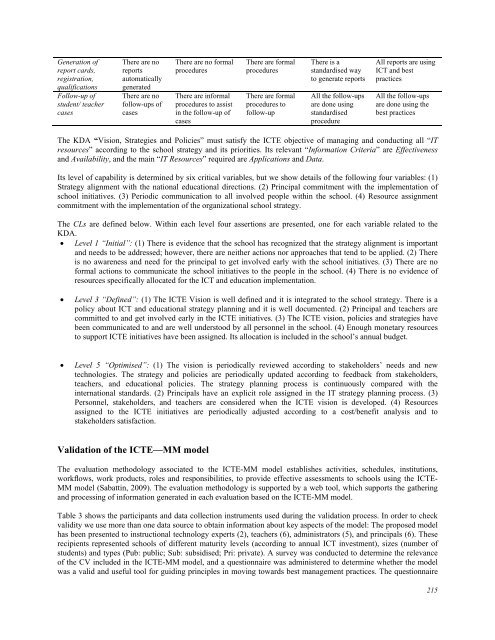A Maturity Model for Assessing the Use of ICT in School Education
A Maturity Model for Assessing the Use of ICT in School Education
A Maturity Model for Assessing the Use of ICT in School Education
Create successful ePaper yourself
Turn your PDF publications into a flip-book with our unique Google optimized e-Paper software.
Generation <strong>of</strong><br />
report cards,<br />
registration,<br />
qualifications<br />
Follow-up <strong>of</strong><br />
student/ teacher<br />
cases<br />
There are no<br />
reports<br />
automatically<br />
generated<br />
There are no<br />
follow-ups <strong>of</strong><br />
cases<br />
There are no <strong>for</strong>mal<br />
procedures<br />
There are <strong>in</strong><strong>for</strong>mal<br />
procedures to assist<br />
<strong>in</strong> <strong>the</strong> follow-up <strong>of</strong><br />
cases<br />
There are <strong>for</strong>mal<br />
procedures<br />
There are <strong>for</strong>mal<br />
procedures to<br />
follow-up<br />
There is a<br />
standardised way<br />
to generate reports<br />
All <strong>the</strong> follow-ups<br />
are done us<strong>in</strong>g<br />
standardised<br />
procedure<br />
All reports are us<strong>in</strong>g<br />
<strong>ICT</strong> and best<br />
practices<br />
All <strong>the</strong> follow-ups<br />
are done us<strong>in</strong>g <strong>the</strong><br />
best practices<br />
The KDA “Vision, Strategies and Policies” must satisfy <strong>the</strong> <strong>ICT</strong>E objective <strong>of</strong> manag<strong>in</strong>g and conduct<strong>in</strong>g all “IT<br />
resources” accord<strong>in</strong>g to <strong>the</strong> school strategy and its priorities. Its relevant “In<strong>for</strong>mation Criteria” are Effectiveness<br />
and Availability, and <strong>the</strong> ma<strong>in</strong> “IT Resources” required are Applications and Data.<br />
Its level <strong>of</strong> capability is determ<strong>in</strong>ed by six critical variables, but we show details <strong>of</strong> <strong>the</strong> follow<strong>in</strong>g four variables: (1)<br />
Strategy alignment with <strong>the</strong> national educational directions. (2) Pr<strong>in</strong>cipal commitment with <strong>the</strong> implementation <strong>of</strong><br />
school <strong>in</strong>itiatives. (3) Periodic communication to all <strong>in</strong>volved people with<strong>in</strong> <strong>the</strong> school. (4) Resource assignment<br />
commitment with <strong>the</strong> implementation <strong>of</strong> <strong>the</strong> organizational school strategy.<br />
The CLs are def<strong>in</strong>ed below. With<strong>in</strong> each level four assertions are presented, one <strong>for</strong> each variable related to <strong>the</strong><br />
KDA.<br />
Level 1 “Initial”: (1) There is evidence that <strong>the</strong> school has recognized that <strong>the</strong> strategy alignment is important<br />
and needs to be addressed; however, <strong>the</strong>re are nei<strong>the</strong>r actions nor approaches that tend to be applied. (2) There<br />
is no awareness and need <strong>for</strong> <strong>the</strong> pr<strong>in</strong>cipal to get <strong>in</strong>volved early with <strong>the</strong> school <strong>in</strong>itiatives. (3) There are no<br />
<strong>for</strong>mal actions to communicate <strong>the</strong> school <strong>in</strong>itiatives to <strong>the</strong> people <strong>in</strong> <strong>the</strong> school. (4) There is no evidence <strong>of</strong><br />
resources specifically allocated <strong>for</strong> <strong>the</strong> <strong>ICT</strong> and education implementation.<br />
Level 3 “Def<strong>in</strong>ed”: (1) The <strong>ICT</strong>E Vision is well def<strong>in</strong>ed and it is <strong>in</strong>tegrated to <strong>the</strong> school strategy. There is a<br />
policy about <strong>ICT</strong> and educational strategy plann<strong>in</strong>g and it is well documented. (2) Pr<strong>in</strong>cipal and teachers are<br />
committed to and get <strong>in</strong>volved early <strong>in</strong> <strong>the</strong> <strong>ICT</strong>E <strong>in</strong>itiatives. (3) The <strong>ICT</strong>E vision, policies and strategies have<br />
been communicated to and are well understood by all personnel <strong>in</strong> <strong>the</strong> school. (4) Enough monetary resources<br />
to support <strong>ICT</strong>E <strong>in</strong>itiatives have been assigned. Its allocation is <strong>in</strong>cluded <strong>in</strong> <strong>the</strong> school’s annual budget.<br />
Level 5 “Optimised”: (1) The vision is periodically reviewed accord<strong>in</strong>g to stakeholders’ needs and new<br />
technologies. The strategy and policies are periodically updated accord<strong>in</strong>g to feedback from stakeholders,<br />
teachers, and educational policies. The strategy plann<strong>in</strong>g process is cont<strong>in</strong>uously compared with <strong>the</strong><br />
<strong>in</strong>ternational standards. (2) Pr<strong>in</strong>cipals have an explicit role assigned <strong>in</strong> <strong>the</strong> IT strategy plann<strong>in</strong>g process. (3)<br />
Personnel, stakeholders, and teachers are considered when <strong>the</strong> <strong>ICT</strong>E vision is developed. (4) Resources<br />
assigned to <strong>the</strong> <strong>ICT</strong>E <strong>in</strong>itiatives are periodically adjusted accord<strong>in</strong>g to a cost/benefit analysis and to<br />
stakeholders satisfaction.<br />
Validation <strong>of</strong> <strong>the</strong> <strong>ICT</strong>E—MM model<br />
The evaluation methodology associated to <strong>the</strong> <strong>ICT</strong>E-MM model establishes activities, schedules, <strong>in</strong>stitutions,<br />
workflows, work products, roles and responsibilities, to provide effective assessments to schools us<strong>in</strong>g <strong>the</strong> <strong>ICT</strong>E-<br />
MM model (Sabatt<strong>in</strong>, 2009). The evaluation methodology is supported by a web tool, which supports <strong>the</strong> ga<strong>the</strong>r<strong>in</strong>g<br />
and process<strong>in</strong>g <strong>of</strong> <strong>in</strong><strong>for</strong>mation generated <strong>in</strong> each evaluation based on <strong>the</strong> <strong>ICT</strong>E-MM model.<br />
Table 3 shows <strong>the</strong> participants and data collection <strong>in</strong>struments used dur<strong>in</strong>g <strong>the</strong> validation process. In order to check<br />
validity we use more than one data source to obta<strong>in</strong> <strong>in</strong><strong>for</strong>mation about key aspects <strong>of</strong> <strong>the</strong> model: The proposed model<br />
has been presented to <strong>in</strong>structional technology experts (2), teachers (6), adm<strong>in</strong>istrators (5), and pr<strong>in</strong>cipals (6). These<br />
recipients represented schools <strong>of</strong> different maturity levels (accord<strong>in</strong>g to annual <strong>ICT</strong> <strong>in</strong>vestment), sizes (number <strong>of</strong><br />
students) and types (Pub: public; Sub: subsidised; Pri: private). A survey was conducted to determ<strong>in</strong>e <strong>the</strong> relevance<br />
<strong>of</strong> <strong>the</strong> CV <strong>in</strong>cluded <strong>in</strong> <strong>the</strong> <strong>ICT</strong>E-MM model, and a questionnaire was adm<strong>in</strong>istered to determ<strong>in</strong>e whe<strong>the</strong>r <strong>the</strong> model<br />
was a valid and useful tool <strong>for</strong> guid<strong>in</strong>g pr<strong>in</strong>ciples <strong>in</strong> mov<strong>in</strong>g towards best management practices. The questionnaire<br />
215
















